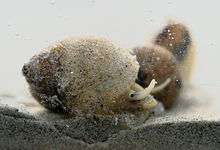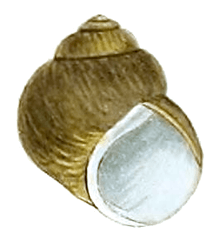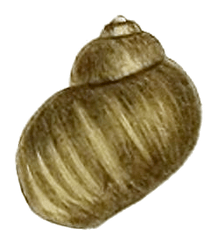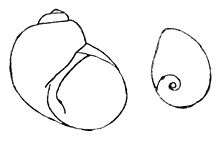Lithoglyphus naticoides
Lithoglyphus naticoides , the gravel snail, is a species of small or minute freshwater snail with an operculum, an aquatic gastropod mollusk in the family Lithoglyphidae.
| Lithoglyphus naticoides | |
|---|---|
 | |
| Live individuals of Lithoglyphus naticoides | |
| Scientific classification | |
| Kingdom: | |
| Phylum: | |
| Class: | |
| (unranked): | |
| Superfamily: | |
| Family: | |
| Subfamily: | Lithoglyphinae |
| Genus: | |
| Species: | L. naticoides |
| Binomial name | |
| Lithoglyphus naticoides | |
| Synonyms | |
|
Paludina naticoides Pfeiffer, 1828 | |
Lithoglyphus naticoides is the type species of the genus Lithoglyphus.[4]
Distribution
The distribution of Lithoglyphus naticoides in the Pliocene ranged from Western Europe to Western Siberia.[1] Its distribution subsequently shrank to the Ponto-Azov area during cooler eras.[1]
The distribution of this species is Pontic.[5] The native distribution includes only Black Sea rivers and the Danube up to Regensburg, from southeastern to central Europe.[6]
It has also artificially colonized other parts of Europe. After 1800 it was introduced to the Elbe and Rhine regions.[6]
After 1960 it has become almost extinct due to water pollution in central Europe.[6]
This snail is found in the following countries:
Western Europe:
- Netherlands
- France[7][1]
Central Europe:
- Austria
- Czech Republic - endangered[8] in Moravia[9]
- Germany - high endangered (Stark gefährdet)[10] It is critically endangered in Sachsen-Anhalt and in Baden-Württemberg.[6]
- Poland - endangered, non-indigenous[11]
- Slovakia[9]
Eastern Europe:
- Latvia
- Lithuania
- Belarus[12][1]
- Ukraine[1]
- Russia[1] It was found in the delta of Volga river in 1971.[1] It has spread upstream since 1971 inhabiting also reservoirs including: Volgograd Reservoir, Saratov Reservoir, Kuybyshev Reservoir and Gorky Reservoir.[1]
- Turkey[13]
Asia:
- Bukhtarminskoe Reservoir on the Irtysh River in Kazakhstan[1] It has reached population densities of 700 snails per m² there.[1]
North America:
Description
This species is called "naticoides" because in shape and general appearance the shell and the operculum of this species is reminiscent of the shell and the operculum of the marine moon snails or Naticidae (for example, the Northern moon snail).
The shell is globular, light grey to greenish yellow or dark.[6] The shell has 4.5-5 whorls.[14] The last whorl is predominating.[6] Dimensions of the shell are 7–10 mm × 7–10 mm.[6] Or the width of the shell is 6.5–8 mm.[14] The height of the shell is 7–9 mm.[14]
 Drawing of apertural view of a shell |
 Drawing of abapertural view of a shell |
 Outline drawing of a shell of Lithoglyphus naticoides and its operculum |
The animal has a broad foot.[6] Males are often smaller than females.[6]
Ecology
It lives in rivers, lakes, channels and reservoirs.[1] In rivers, it lives at sites with low water currents, on solid muddy soils and at stones.[6] It requires high oxygen and calcium carbonate contents.[6] The population diversity reached up to 3.300 snails per m² according to Krause (1949).[15][14] It can live in salinity up to 3 ‰.[14]
Lithoglyphus naticoides feeds on diatomes and green alga.[14]
The life cycle of Lithoglyphus naticoides takes one year.[1] Reproduction of Lithoglyphus naticoides takes place mainly in July.[1] The morphology of the egg capsules has been described by Berezkina (2010).[16] The life span is 4–5 years.[14]
Parasites of Lithoglyphus naticoides include:
Human use
Perforated shells of Lithoglyphus naticoides were found in a Neolithic grave in Lower Austria as a head decoration.[20]
References
This article incorporates public domain text from the reference[6]
- Yakovlev V. A., Akhmetzyanova N. Sh. & Yakovleva A. V. (2010). "Distributional patterns and size-weight parameters of Lithoglyphus naticoides (Gastropoda: Hydrobiidae) in the upper reach of the Kuibyshev Reservoir". Russian Journal of Biological Invasions 1(4): 313-322. doi:10.1134/S2075111710040090.
- Van Damme D. (2011). "Lithoglyphus naticoides". The IUCN Red List of Threatened Species. Version 2014.2. <www.iucnredlist.org>. Downloaded on 14 August 2014.
- Pfeiffer C. (1828). Naturgeschichte deutscher Land- und Süsswasser-Mollusken. Vol. 3 (1828): 84 pp. + 8 tables. Weimar. (Landes-Industrie-Comptoir). page 45, Taf. 8, Fig. 1, 2, 4.
- "Species in genus Lithoglyphus". AnimalBase, accessed 22 May 2011.
- (in Slovak) Lisický M. J. (1991). Mollusca Slovenska [The Slovak molluscs]. VEDA vydavateľstvo Slovenskej akadémie vied, Bratislava, 344 pp.
- "Species summary for Lithoglyphus naticoides". AnimalBase, last modified 24 February 2009, accessed 22 May 2011.
- Mouthon J. (2007). "Lithoglyphus naticoides (Pfeiffer) (Gastropoda: Prosobranchia): distribution in France, population dynamics and life cycle in the Saône river at Lyon (France)". Annales de Limnologie - International Journal of Limnology 43(1): 53-59. doi:10.1051/limn/2007027.
- (in Czech) "Red List of the molluscs (Mollusca) of the Czech Republic". accessed 22 May 2011.
- (in Czech) Horsák M., Juřičková L., Beran L., Čejka T. & Dvořák L. (2010). "Komentovaný seznam měkkýšů zjištěných ve volné přírodě České a Slovenské republiky. [Annotated list of mollusc species recorded outdoors in the Czech and Slovak Republics]". Malacologica Bohemoslovaca, Suppl. 1: 1-37. PDF.
- Glöer P. & Meier-Brook C. (2003). Süsswassermollusken. DJN, pp. 134, page 107, ISBN 3-923376-02-2
- Piechocki A. "Lithoglyphus naticoides (C. Pfeiffer, 1828)". Polish Red Data Book of Animals, accessed 22 May 2011.
- Mastitsky S. E. & Samoilenko V. M. (2006). "The gravel snail, Lithoglyphus naticoides (Gastropoda: Hydrobiidae), a new Ponto-Caspian species in Lake Lukomskoe (Belarus)". Aquatic Invasions 1(3): 161-170. doi:10.3391/ai.2006.1.3.11, PDF Archived 2007-09-28 at the Wayback Machine.
- Yildirim M. Z., Koca S. B. & Kebapçi U. (2006). "Supplement to the Prosobranchia (Mollusca: Gastropoda) Fauna of Fresh and Brackish Waters of Turkey". Turkish Journal of Zoology 30: 197-204. PDF.
- Glöer P. (2002). Die Süßwassergastropoden Nord- und Mitteleuropas. Die Tierwelt Deutschlands, ConchBooks, Hackenheim, 326 pp., ISBN 3-925919-60-0.
- (in German) Krause H. (1949). "Untersuchungen zur Anatomie und Ökoelogie von Lithoglyphus naticoides (C. Pfeiffer)". Arch. Moll. 78: 103-148.
- Berezkina G. V. (2010). "The morphology of egg capsules and syncapsules in freshwater Pectinibranchia (Mollusca: Gastropoda)". Inland Water Biology 3(1): 27-37. doi:10.1134/S1995082910010049.
- Zhokhov A. E., Molodozhnikova N. M. & Pugacheva M. N. (2006). "Dispersal of invading trematodes Nicolla skrjabini (Iwanitzky, 1928) and Plagioporus skrjabini Kowal, 1951 (Trematoda: Opecoelidae) in the Volga". Russian Journal of Ecology 37(5): 363-365. doi:10.1134/S1067413606050110.
- Tyutin A. V. & Slynko Yu. V. (2010). "The first finding of the Black Sea snail Lithoglyphus naticoides (Gastropoda) and its associated species-specific trematoda in the Upper Volga basin". Russian Journal of Biological Invasions 1(1): 45-49. doi:10.1134/S2075111710010091.
- (in German) Odening K. (1970). "Der Entwicklungszyklus von Apophallus muehlingi (Trematoda: Opisthorchiida: Heterophyidae) in Berlin ". Parasitology Research 33(3): 194-210. doi:10.1007/BF00259490.
- Harzhauser M., Lenneis E., & Neugebauer-Maresch C. (2007). "Freshwater gastropods as Neolithic adornment: size selectiveness and perforation morphology as a result of grinding techniques". Annalen des Naturhistorischen Museums in Wien 109A 73-85. PDF.
External links
| Wikimedia Commons has media related to Lithoglyphus naticoides. |
- (in Polish) Kołodziejczyk A. (2001). "Nowe stanowisko Lithoglyphus naticoides (C. Pfeiffer, 1828) (Gastropoda, Hydrobiidae) w Polsce". Przeg. zool. 45: 79-81.
